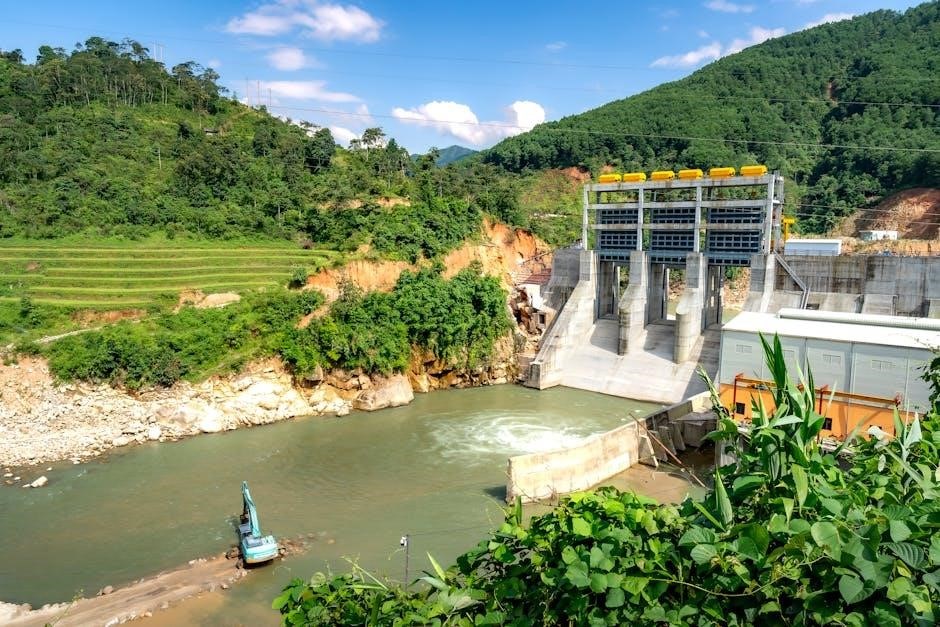energy flow in ecosystem pdf
Energy flow in ecosystems is a process where energy is transferred from one level to another,
starting with solar energy
and then to producers and consumers, with a gradual loss of energy at each level naturally.
Definition of Ecosystem and Energy Flow
An ecosystem is a functional unit where energy and nutrients flow between the abiotic environment and living organisms, and energy flow refers to the transfer of energy from one level to another.
The ecosystem consists of a community, which is the sum total of all living organisms, and their interactions with the environment.
Energy flow is a crucial aspect of an ecosystem, as it determines the structure and function of the ecosystem.
The energy flow in an ecosystem can be defined as the flow of energy from one trophic level to another, starting with the producers, such as plants, and transferring to consumers, such as animals.
This flow of energy is essential for the survival of organisms in the ecosystem, as it provides them with the necessary energy for growth, development, and maintenance.
The definition of ecosystem and energy flow is closely related, as energy flow is a key process that occurs within an ecosystem, and it plays a vital role in maintaining the balance and stability of the ecosystem.
The understanding of energy flow in an ecosystem is essential for managing and conserving ecosystems, as it helps to identify the key components and processes that need to be maintained or restored.
By studying energy flow, we can gain insights into the complex interactions between organisms and their environment, and how these interactions affect the overall functioning of the ecosystem.
This knowledge can be used to develop strategies for sustainable management of ecosystems, and to mitigate the impacts of human activities on the environment.
Overall, the definition of ecosystem and energy flow provides a foundation for understanding the complex relationships between organisms and their environment, and how energy flows through the ecosystem.
Energy flow is a critical component of an ecosystem, and its study has important implications for ecology, conservation, and environmental management.

Importance of Energy Flow in Ecosystems
Energy flow is crucial for ecosystem functioning and maintenance of ecological balance, supporting life and regulating Earth’s climate naturally every day.
Trophic Levels and Energy Transfer
Energy transfer occurs between trophic levels, which are nutritional levels in an ecosystem, including producers, primary consumers, and secondary consumers. The energy is transferred from one trophic level to the next through the food chain.
Each trophic level has a specific role in the ecosystem, with producers, such as plants, converting sunlight into energy through photosynthesis.
Primary consumers, like herbivores, feed on producers, while secondary consumers, like carnivores, feed on primary consumers, and so on, with energy being transferred at each level, resulting in a gradual loss of energy.
The study of trophic levels and energy transfer is essential to understanding the complex relationships within ecosystems and how they function, as well as the impact of human activities on these delicate systems, and the importance of conservation efforts to maintain ecological balance.
Understanding energy transfer between trophic levels can help us better manage ecosystems and mitigate the effects of environmental changes, ultimately contributing to the health and sustainability of our planet.

Energy Flow Models
Energy flow models describe the movement of energy through ecosystems, using
diagrams and equations to illustrate energy transfer and loss, helping to understand ecosystem dynamics and functioning naturally always.
Types of Energy Flow Models
There are several types of energy flow models, including the universal energy flow model, single channel energy flow model, and double channel or Y-shaped flow model. These models help to illustrate the movement of energy through ecosystems, from producers to consumers, and the loss of energy at each level. The universal energy flow model describes the gradual loss of energy as it moves through the ecosystem, while the single channel energy flow model shows the transfer of energy from one trophic level to the next. The double channel or Y-shaped flow model illustrates the transfer of energy from producers to both primary and secondary consumers. These models are useful tools for understanding ecosystem dynamics and functioning, and can be used to predict the effects of changes to the ecosystem on energy flow. Energy flow models are an important part of ecosystem study, and are used in a variety of fields, including ecology and conservation.

Energy Sources and Conversion
Energy sources include solar, chemical, and heat energy, with solar energy being the primary source, converted into other forms through ecosystem processes naturally and efficiently every day.
Solar Energy and Its Role in Ecosystems
Solar energy is the primary source of energy for ecosystems, driving the process of photosynthesis in plants, which produces glucose and oxygen. This energy is then transferred to herbivores and carnivores through the food chain. The amount of solar energy that enters an ecosystem determines the amount of energy available to support life. Solar energy also plays a crucial role in regulating the climate and weather patterns of an ecosystem, which in turn affects the distribution and abundance of organisms. The energy from the sun is essential for the growth and development of plants, which form the base of the food web. Without solar energy, ecosystems would not be able to function, and life as we know it would not exist. The role of solar energy in ecosystems is vital, and its importance cannot be overstated, as it is the driving force behind the energy flow in ecosystems, supporting all life forms.

Ecological Balance and Energy Flow
Maintaining ecological balance is crucial for stable energy flow, ensuring the long-term health of ecosystems and supporting biodiversity naturally through various processes and interactions between organisms and environment.
Consequences of Disrupting Energy Flow in Ecosystems
Disrupting energy flow in ecosystems can have severe consequences, including loss of biodiversity, changes in population dynamics, and alterations to nutrient cycles.
Human activities such as deforestation, pollution, and climate change can disrupt energy flow, leading to ecosystem degradation and loss of ecosystem services.
Understanding the consequences of disrupting energy flow is essential for managing and conserving ecosystems, and for maintaining ecological balance and promoting sustainable development.
Ecosystems provide essential services, including air and water purification, soil formation, and climate regulation, and disrupting energy flow can compromise these services.
Conservation efforts should focus on restoring and maintaining energy flow in ecosystems to ensure the long-term health and resilience of ecosystems, and to support human well-being and sustainable development.
By managing human activities that disrupt energy flow, we can help maintain ecological balance and promote ecosystem services, ultimately supporting the health and well-being of both ecosystems and human societies.

